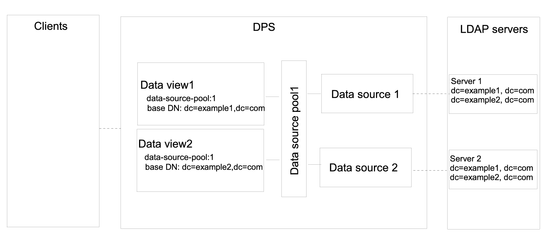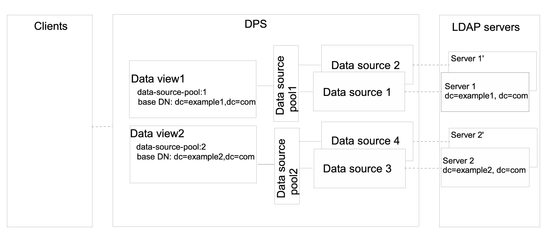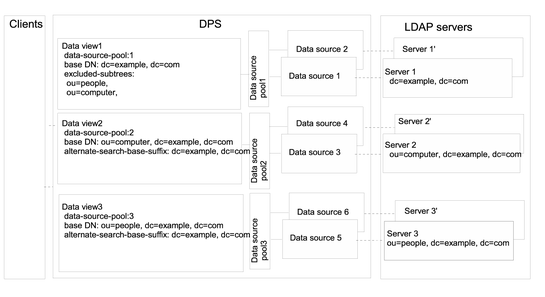| Skip Navigation Links | |
| Exit Print View | |

|
Oracle Directory Server Enterprise Edition Administration Guide 11g Release 1 (11.1.1.5.0) |
| Skip Navigation Links | |
| Exit Print View | |

|
Oracle Directory Server Enterprise Edition Administration Guide 11g Release 1 (11.1.1.5.0) |
Part I Directory Server Administration
2. Directory Server Instances and Suffixes
3. Directory Server Configuration
6. Directory Server Access Control
7. Directory Server Password Policy
8. Directory Server Backup and Restore
9. Directory Server Groups, Roles, and CoS
10. Directory Server Replication
13. Directory Server Attribute Value Uniqueness
15. Directory Server Monitoring
Part II Directory Proxy Server Administration
16. Directory Proxy Server Tools
17. Directory Proxy Server Instances
Creating and Configuring LDAP Data Sources
To Configure an LDAP Data Source
Creating and Configuring LDAP Data Source Pools
To Create an LDAP Data Source Pool
To Configure an LDAP Data Source Pool
Attaching LDAP Data Sources to a Data Source Pool
To Attach an LDAP Data Source to a Data Source Pool
To Configure an LDAP Data View
Accessing Configuration Entries for a Directory Server by Using Directory Proxy Server
To Access the Configuration Entries of a Directory Server by Using Directory Proxy Server
To Configure Attribute Renaming
Configuring View Exclusion Base and Alternate Search Base
To Manually Configure the excluded-subtrees and alternate-search-base-dn Properties
Creating and Configuring Data Views for Example Use Cases
Data Views That Route All Requests, Irrespective of the Target DN of the Request
19. Directory Proxy Server Certificates
20. Directory Proxy Server Load Balancing and Client Affinity
21. Directory Proxy Server Distribution
22. Directory Proxy Server Virtualization
23. Virtual Data Transformations
24. Connections Between Directory Proxy Server and Back-End LDAP Servers
25. Connections Between Clients and Directory Proxy Server
26. Directory Proxy Server Client Authentication
27. Directory Proxy Server Logging
28. Directory Proxy Server Monitoring and Alerts
Part III Directory Service Control Center Administration
This section contains the following information about data views and how to create and configure them:
The examples in this section assume that the connection handler allows all client connections to be processed by Directory Proxy Server.
If you create a data view without configuring any of the properties, your data view has the following configuration:
alternate-search-base-dn : "" alternate-search-base-dn : base-DN attr-name-mappings : none base-dn : suffix-DN contains-shared-entries : - description : - distribution-algorithm : - dn-join-rule : - dn-mapping-attrs : none dn-mapping-source-base-dn : none excluded-subtrees : - filter-join-rule : - is-enabled : true is-read-only : false is-routable : true ldap-data-source-pool : pool-name lexicographic-attrs : all lexicographic-lower-bound : none lexicographic-upper-bound : none non-viewable-attr : - non-writable-attr : - numeric-attrs : all numeric-default-data-view : false numeric-lower-bound : none numeric-upper-bound : none pattern-matching-base-object-search-filter : all pattern-matching-dn-regular-expression : all pattern-matching-one-level-search-filter : all pattern-matching-subtree-search-filter : all process-bind : - replication-role : master viewable-attr : all except non-viewable-attr writable-attr : all except non-writable-attr
This section shows the configuration of a data view that routes all the requests that do not match their targets mentioned in their target DNs, to a data source pool. This data view is called the root data view. The root data view is created by default when an instance of Directory Proxy Server is created. For information about the root data view, see Data Views to Route All Requests, Irrespective of the Target DN of the Request in Oracle Directory Server Enterprise Edition Reference.
The root data view has the following configuration:
alternate-search-base-dn : -
attr-name-mappings : none
base-dn : ""
contains-shared-entries : -
description : Automatically-generated data view
able to route client operations
independently of the operation base dn
distribution-algorithm : -
dn-join-rule : -
dn-mapping-attrs : none
dn-mapping-source-base-dn : none
excluded-subtrees : ""
excluded-subtrees : cn=config
excluded-subtrees : cn=monitor
excluded-subtrees : cn=proxy manager
excluded-subtrees : cn=virtual access controls
excluded-subtrees : dc=example,dc=com
filter-join-rule : -
is-enabled : true
is-read-only : false
is-routable : true
ldap-data-source-pool : defaultDataSourcePool
lexicographic-attrs : all
lexicographic-lower-bound : none
lexicographic-upper-bound : none
non-viewable-attr : -
non-writable-attr : -
numeric-attrs : all
numeric-default-data-view : false
numeric-lower-bound : none
numeric-upper-bound : none
pattern-matching-base-object-search-filter : all
pattern-matching-dn-regular-expression : all
pattern-matching-one-level-search-filter : all
pattern-matching-subtree-search-filter : all
process-bind : -
replication-role : master
viewable-attr : all except non-viewable-attr
writable-attr : all except non-writable-attr
This section describes how to configure a data view that routes requests targeted at a list of subtrees to a set of data-equivalent data sources. For information about this type of deployment, see Data Views to Route Requests When a List of Subtrees Are Stored on Multiple, Data-Equivalent Data Sources in Oracle Directory Server Enterprise Edition Reference.
The example in this section has multiple data sources that contain the same set of subtrees. The data sources are data-equivalent and are pooled into one data source pool for load balancing. A data view is configured for each subtree to expose that subtree to client requests. The following figure shows the sample deployment.
Figure 18-1 Sample Deployment That Routes Requests When a List of Subtrees Is Stored on Multiple, Data-Equivalent Data Sources

You can use DSCC to perform this task. For information, see Directory Service Control Center Interface and the DSCC online help.
For information, see Configuring Load Balancing.
$ dpconf create-ldap-data-view -h host1 -p 1389 dataview-1 \ data-source-pool-1 dc=example1,dc=com
$ dpconf create-ldap-data-view -h host1 -p 1389 dataview-2 \ data-source-pool-1 dc=example2,dc=com
The other properties of the data views are the same as the default data view in Default Data View.
For information about restarting Directory Proxy Server, see To Restart Directory Proxy Server.
This section describes how to configure a data view that provides a single point of access to different subtrees stored in multiple data sources. For information about this type of deployment, see Data Views to Provide a Single Point of Access When Different Subtrees Are Stored on Different Data Sources in Oracle Directory Server Enterprise Edition Reference.
The example in this section contains a data view for each subtree. A data source pool is configured for each set of data-equivalent data sources. The following figure shows the example deployment.
Figure 18-2 Sample Deployment That Provides a Single Point of Access When Different Subtrees Are Stored on Different Data Sources

You can use DSCC to perform this task. For information, see Directory Service Control Center Interface and the DSCC online help.
For information, see Configuring Load Balancing.
$ dpconf create-ldap-data-view -h host1 -p 1389 dataview-1 \ data-source-pool-1 dc=example1,dc=com
$ dpconf create-ldap-data-view -h host1 -p 1389 dataview-2 \ data-source-pool-1 dc=example2,dc=com
The other properties of the data views are the same as the default data view in Default Data View.
For information about restarting Directory Proxy Server, see To Restart Directory Proxy Server.
This section describes how to configure a data view for a single point of access when a superior branch of a subtree is stored in a different data source to a subordinate branch. For information about this type of deployment, see Data Views to Route Requests When Superior and Subordinate Subtrees Are Stored in Different Data Sources in Oracle Directory Server Enterprise Edition Reference.
The example in this section contains three data views. The base DN of data view 1 is superior to the base DN of data view 2 and the base DN of data view 3. Or, in other words, data source 2 and data source 3 contain subtrees that are subordinate to the subtree on data source 1. The following figure shows the example deployment.
Figure 18-3 Sample Deployment to Routes Requests When Superior and Subordinate Subtrees Are Stored in Different Data Sources

Directory Proxy Server automatically excludes a subordinate branch of a subtree from a data view when the subordinate branch is configured as the base DN of a separate data view.
You can use DSCC to perform this task. For information, see Directory Service Control Center Interface and the DSCC online help.
Attach the data sources that contain dc=example,dc=com to data-source-pool-1.
Attach the data sources that contain ou=computer,dc=example,dc=com to data-source-pool-2.
Attach the data sources that contain ou=people,dc=example,dc=com to data-source-pool-3.
For information, see Configuring Load Balancing.
$ dpconf create-ldap-data-view -h host1 -p 1389 dataview-1 \ data-source-pool-1 dc=example,dc=com
$ dpconf create-ldap-data-view -h host1 -p 1389 dataview-2 \ data-source-pool-2 ou=computer,dc=example,dc=com
$ dpconf create-ldap-data-view -h host1 -p 1389 dataview-3 \ data-source-pool-3 ou=people,dc=example,dc=com
$ dpconf get-ldap-data-view-prop -h host1 -p 1389 dataview-1 excluded-subtrees
The list of excluded subtrees is returned.
For information about restarting Directory Proxy Server, see To Restart Directory Proxy Server.